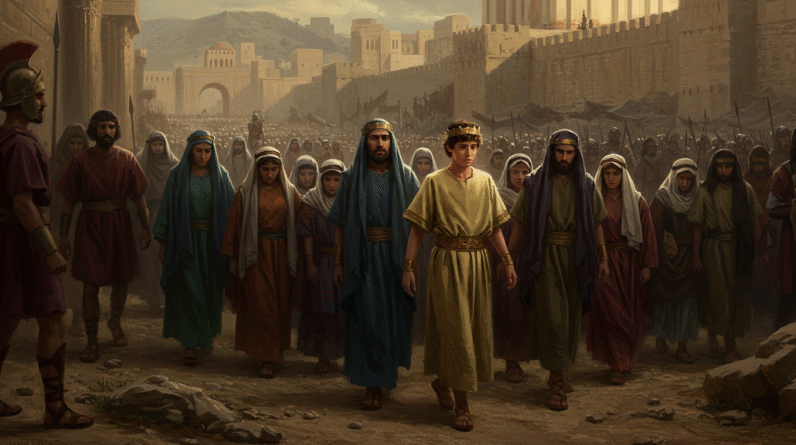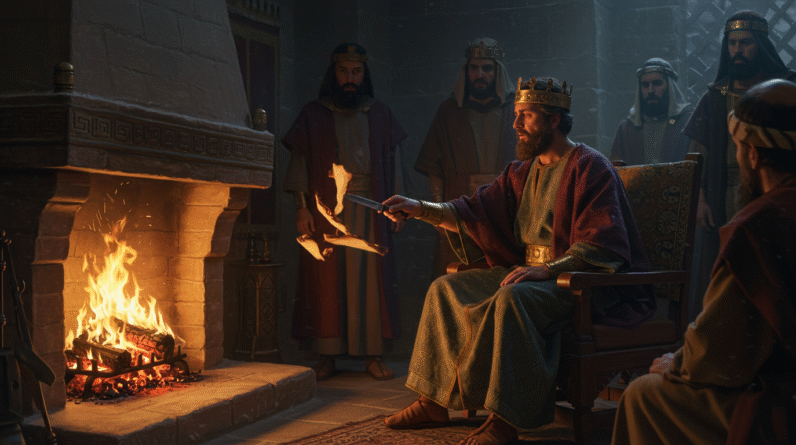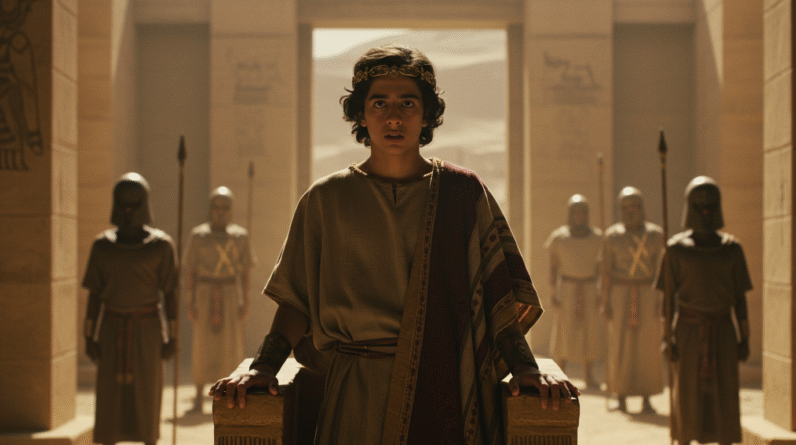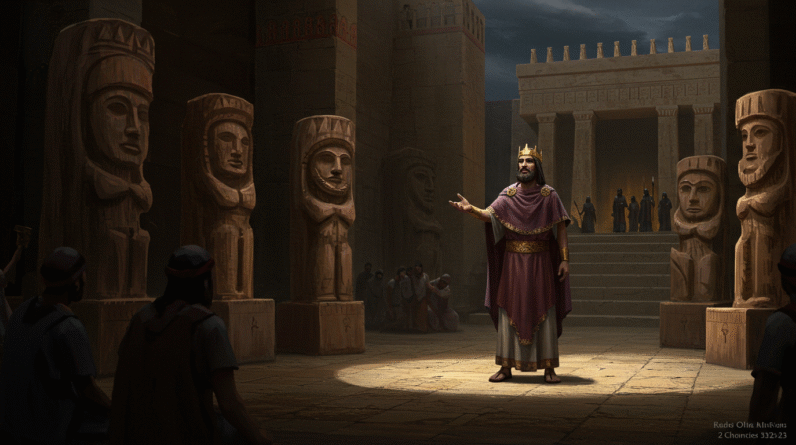Athaliah — The Queen Who Tried To Wipe Out David’s Line (2 Kings 11:1–3)
You come to this story and the first thing that hits you is how ordinary it looks on the surface: a royal death, a ruthless grab for power, a child hidden away, a priest who has to choose between safety and defiance. The text itself is concise; the implications are not. Read the opening sentences of the episode and you’ll see what I mean: 2 Kings 11:1–3. It tells you in a few clauses that Athaliah took power and that one child — Joash — was preserved. From there, the story fans out into family ties, political purges, priestly intervention, and a small, stubborn hope that the covenant God had made with David might survive human malice.
If you’re reading this because the image of a queen executing a purge catches your eye, or because you’ve been struck by how often sacred narratives hinge on very human calculations of risk and loyalty, you’ll find this story rewards close attention. It’s not only a political thriller; it’s a moral experiment: what gets preserved when institutions collapse, and what does it mean to preserve a line that is also a theology?
Why this story matters to you
You want to understand a short, sharp episode in the history of Judah and how it plays out the themes that keep repeating across the books of Kings and Chronicles: dynasty, covenant, power, and legitimacy. You also want to notice the characters who are small in number but large in effect — the unnamed watchful servants, the priest who risks everything, the woman who hides a child in a temple room, the child himself who will grow up with a crown he didn’t ask for. These are the details that make you feel the grit of ancient politics and the tenderness of human survival.
The story is recorded in two parallel accounts, which emphasize different things: the book of Kings gives you sparse details, and Chronicles, written later and with priestly concerns in mind, fills in the civic-religious context more thoroughly. You can read the King’s account here: 2 Kings 11:1–3, and then turn to Chronicles for the fuller procedural and religious texture: 2 Chronicles 22:10–12 and 2 Chronicles 23:11–15.
The political background you should know
To make sense of Athaliah, you need to see what’s been happening in the surrounding chapters. You have to imagine the court in Jerusalem shortly after the death of a king, with factions watching each other’s movements, and a wider geopolitical drama where Israel’s northern dynasty — the house of Ahab — has already been making trouble for Judah for decades.
Athaliah herself is not a native product of Judah’s royal house. She’s connected to the northern house of Omri (through Ahab) and brings those political and religious affiliations with her into the southern court. You can find a brief genealogy and the initial setup in 2 Kings 8:26, which mentions key familial relationships and reminds you of how closely marriage and alliance are intertwined.
The northern purge that Jehu conducts (the assassination campaign that swept away Ahab’s family and supporters) sets the immediate stage. That purge produces a vacuum of safety for any of Ahab’s descendants who are linked to Judah’s ruling house. The relevant episodes are in 2 Kings 9–10 — read especially the parts where Jehu’s men carry out his bloody mandate (2 Kings 10:29–31). For you, that context explains why Athaliah would react with brutal speed: the palace is brittle and the purges she knows have happened just across the kingdom.
How Chronicles frames the coup
Chronicles, written later and with an interest in temple and priesthood, tend to present events through the lens of cultic stability and priestly agency. The Chronicler tells you how Jehu’s purge led to Ahaziah’s death and how Athaliah reacted in Jerusalem. Read 2 Chronicles 22:1–12 for this fuller setup. In Chronicles, the priestly figures like Jehoiada are central actors; their decisions are theological as well as political. That framing shapes how you should read the coup: not merely as a dynastic struggle but as a threat to an institutional memory about God’s promises.
Read the episode: 2 Kings 11:1–3 and what it says plainly
The passage itself is short and written in the austere style that you’ve learned to expect from Kings. It gives you the skeleton of events:
- Ahaziah is killed, and Athaliah seizes the opportunity.
- She then proceeds to “destroy the whole royal family,” seeking to eliminate any rival claimants.
- But there is a saved child — Joash — who is spirited away and hidden in the house of the Lord by Jehosheba, daughter of the king, and wife of Jehoiada the priest, where he remains for six years.
- During that time, Athaliah ruled over the land.
You can read the passage, and then look at how Chronicles expands the narrative: 2 Kings 11:4–16 and 2 Chronicles 23:8–15 give you the dramatized execution of the coup and the priestly counter-move that crowns Joash and kills Athaliah.
This is a story told in three movements: the violent consolidation of power, the hidden preservation, and the eventual revelation. The initial verses — 2 Kings 11:1–3 — are the hinge. They tell you plainly that Athaliah was thorough in her attempt to wipe out the Davidic line, and that, against all odds, someone guarded the promise.
Athaliah: who she is and why she matters
You might be tempted to reduce Athaliah to a villain headline — “the queen who tried to wipe out David’s line” — and that’s partly what the biblical text wants you to do. She is the antagonist in a narrative that celebrates the survival of David’s dynasty. But if you look at her biography and the politics of her time, she is also a figure who makes sense of her own actions.
Athaliah is a royal product of political marriage. She’s tied by blood to the northern house that worshipped Baal, and that connection matters. You get the genealogical hint in 2 Chronicles 22:2–4, where the Chronicler reminds you of her Ahabite pedigree and the influence that carries. She is part of a lineage that has been both conspicuously powerful and also violently targeted. In political terms, it’s not difficult to see why she moves as she does: the palace is suddenly exposed, and the likelihood that rivals will seek to eliminate you by any means is very real.
She matters because she tests institutions. If the Davidic line is, in the biblical imagination, the locus of God’s promise, she is the antagonist who makes that promise precarious. The fact that a queen can seize the throne and act decisively reveals the fragility of dynastic continuity and compels the narrative’s other actors — priests and hidden courtiers — to act in ways that are themselves politically consequential.
Athaliah’s method: thoroughness and spectacle
You should notice how thorough Athaliah’s purge is said to be. The words in the text emphasize totality: the “whole royal family” (see 2 Kings 11:1). This kind of language matters because it frames her as someone who understands that symbolic survival is as dangerous as physical survival. If a rival can survive in hiding or in some little branch of the lineage, the threat remains.
Her power is immediate and practical. She demonstrates an understanding that legitimacy is as much about visible succession as it is about force. This is why the palace is the site of such swift action. She aims to eliminate future narratives that could root themselves in bloodline. You feel the cold logic in that attempt: erase the seed and you erase the future.
Joash, Jehosheba, and Jehoiada: the small heroes
You should take in how the story turns on the decisions of a few people who refuse to accept the erasure of a line. Jehosheba — the sister of Ahaziah — becomes the improbable rescuer. Her marriage to the priest Jehoiada places the child Joash in the very institution that Athaliah’s purge threatens: the house of the Lord. The priest’s household becomes a refuge.
The chronicler’s idiom emphasizes their roles and their righteousness. The narrative wants you to see the preservation of Joash as not a random act of pity but a deliberate resistance. Jehoiada’s priestly authority will be critical later, when he marshals troops and orchestrates a public recognition of Joash as the rightful king. You should read the fuller narrative in 2 Kings 11:4–16 and 2 Chronicles 23:11–15 to feel how the priest’s plan reads like a careful surgical intervention in the royal polity.
For you, the drama is about choices under pressure. People who are not the public faces of power yet choose to risk everything so a promise can live. That’s how the story narrativizes faithfulness: not as a grand public manifesto, but as a quiet, dangerous act.
The theological stakes: the Davidic covenant under threat
If you’re trying to read this story theologically, you shouldn’t gloss over the narrator’s concern with lineage. The survival of a Davidic heir is a theological matter because the monarchy in Israel and Judah, as portrayed by these books, is wrapped up with divine promises. The promise to David is not merely private property; it’s the instrument through which the text imagines God’s plans for Israel. So when Athaliah sets out to destroy that line, the story presents it as an attack not merely on a family but on a covenantal future.
The books of Kings and Chronicles tell you, in different ways, that human violence will attempt to thwart divine purpose, but somehow the purpose persists. The preservation of Joash is narrated as a sign that the promise has more resilience than human malice anticipates. Read 2 Kings 11:1–3 beside the broader narrative about the Davidic succession, and you begin to see that these small acts of fidelity are how larger theological promises are kept alive.
For you as a reader, that raises the uncomfortable question: do you assume that institutions will protect promises, or do you notice how often promises survive only because people outside institutional power choose to guard them?
The priesthood and the temple: a necessary political actor
Another thing you should notice is the role of the temple and the priesthood. Jehoiada doesn’t simply hide Joash; he uses the resources of the temple to make Joash’s legitimacy visible. He organizes the Levites, arranges for trumpets and cymbals, and stages a public anointing that reclaims the narrative for David’s line. The Chronicler is particularly interested in this sequence because it shows the temple as a place of political as well as religious agency.
Read 2 Chronicles 23:1–11 and you’ll see how the priestly mobilization reads almost like a coup that has ritual legitimacy. That’s important: legitimacy here is not only about force. It’s also about appearing to enact a sacred rite that connects the people to a promised future. Jehoiada understands performance; he understands that power needs the sanction of ritual if it is to be more than temporary.
That means the temple in Chronicles is not a passive backdrop; it’s an active political stage. For you, that blurs the lines between the spiritual and the political and invites you to consider that, in ancient contexts, they were rarely separate.
Women, violence, and narrative framing
You should feel the way the narrative frames women. Athaliah is painted in broad strokes: a usurper and a murderer. Jehosheba, on the other hand, is a rescuer who acts quietly and without fanfare. The story positions these women opposite one another in terms of their relation to power: one uses violent public assertion to seize the throne, the other uses secrecy and relational loyalty to preserve a child. The contrast makes a moral and narrative point, but you should resist letting that point be the final word.
Athaliah’s identity as the daughter of Ahab brings Jezebel’s infamous reputation into her shadow. The text invites you to read Athaliah alongside Jezebel and to see her as part of an ideological bloc that the biblical authors oppose. But if you press at her motives, you might see someone who believes in her own right to rule and who has reasons — if not moral ones — for her action. The Chronicler’s depiction is polemical; it seeks to explain the restoration of legitimate kingship, and thus it accentuates Athaliah’s villainy. That doesn’t mean you can’t be moved by her complexity, or think about what it costs to be an agent of order in a world of threats.
You should also notice the gendered implications of power here. Athaliah is rare in the historical narrative as a queen regnant; her method of seizing and holding power tells you as much about the political constraints on women as it does about her personal ambition. Read the story with an eye to the gendered lens: the chronicler’s moral framing relies on contrast — female usurper versus male-line legitimacy — but you are allowed to notice the ways that women navigate power in any context.

Violence and legitimacy: how the text justifies the end
One of the uncomfortable things you’ll have to reckon with is how the end — Athaliah’s violent overthrow and death — is narrated as righteous. The text describes how the people seize her and execute her; Chronicles gives you the details of the public spectacle. The moral logic in the narrative is that her removal is necessary to restore the covenant order. For the chronicle writer, this is not revenge but the restoration of proper worship and covenant fidelity.
You can object to the moral framing, and you’re right to do so. The text’s logic is internally consistent for its own worldview, but when you read it as a modern person, you’ll feel the strain: the same violence used to maintain order is also the source of moral tension. The author wants you to endorse the outcome because the outcome produces the kind of religious order the author values. You should notice the way history is being used as a moral argument: the ends justify the means, if the ends are the reinstallation of a divinely chosen dynasty.
If you’re asking how the story sits ethically in the modern mind, you’ll find it hard to endorse the means even if you accept the theological premise. Your discomfort is not accidental; it’s the narrative’s most humanizing element.
The narrative artistry: concision that opens onto drama
You should pay attention to how the books of Kings and Chronicles tell the story differently. Kings is concise, almost brusque; it delivers the facts and moves on. Chronicles is more theatrical; it gives you the costumes, the trumpets, the names of the military units, and the number of years of Joash’s hiding. The chronicler wants you to linger at the temple and to feel the priest’s calculation. For you, the contrast is instructive: one text gives you the skeleton, the other supplies the muscle and skin.
That difference matters because it shapes how you understand the actors’ motives and how you feel about the outcome. Kings invites a more sceptical reading; Chronicles invites a warmer reception of the priestly restoration. Both are necessary to get the moral and political texture of the episode.
The power of small details
Look for what the texts choose to preserve and what they omit. Jehosheba’s name is preserved; her courage is not dramatized with long speeches. Joash’s childhood is summarized as hidden years. The chronicler gives you enough to imagine the scene, but not so much that the story becomes sentimental. In these choices, you see a narrative that trusts you to supply the human dimension: the fear, the whispering corridors, the way a small group of people can alter history by refusing to accept erasure.
Lessons you can take home
You will leave this story with a few practical things to think about. First, institutional promises can be fragile. The Davidic covenant survived political turbulence not because of an abstract force but because people chose to act sacrificially. If you care about preserving something — a principle, a community, a hope — you should remember how preservation often happens in hidden, small acts.
Second, legitimacy is a constructed thing. It requires public rituals and private loyalty, ceremonial affirmation, and the ability to wield force if necessary. Jehoiada’s success depends on both priestly ritual and military force. You can draw from that the uncomfortable truth that moral authority and coercive power often coexist.
Third, the moral landscape in the story resists simple judgments. Athaliah is a political actor, and the text condemns her. But condemning her does not absolve you from asking hard questions about political legitimacy, gender, and the price of restoration. The story invites reflection rather than simple celebration.
Finally, the story tells you about the persistence of a promise. Even when an entire royal family seems doomed, a single child can carry forward a tradition. It’s a strange consolation: sometimes futures hinge on tiny survivals. That should make you pay attention to the small, ordinary acts of courage and care in your own life.
Reading the story today: power, memory, and survival
When you read Athaliah’s story today, there are modern resonances that make the ancient narrative feel more immediate. You can think about how regimes are overthrown and replaced, how institutions fail and survive, how memory is curated and protected. The temple’s role in reshaping political narrative is comparable to modern institutions that control public legitimacy: courts, media, churches, and universities. The story asks you to consider where you place your trust and where you think fidelity matters.
It also asks you about how narratives are written. The chronicler writes to affirm a certain theological view and to show that the temple and priesthood are rightly central to Israel’s life. That rhetorical move has modern analogues: histories are often written by those with an interest in shaping memory. So when you read the ancient text, you read with the knowledge that it is not an impartial record but a theological reflection.
For you, that means reading closely and skeptically together: let the drama move you, but don’t let it replace careful inquiry about what the author wants to persuade you to believe.
Final thoughts — why the story still speaks
You’ll keep thinking about Athaliah because the story bristles with real human stakes: life and death, loyalty and betrayal, a child hidden in a sacred room, a priest who organizes a coup that wears liturgy as its armor. The narrative’s economy is one of its strengths. It doesn’t waste words, but what it does leave unsaid becomes the place your imagination moves into. You wonder about Joash’s childhood, about Jehosheba’s courage in private, about the women who were watched and the soldiers who obeyed.
Ultimately, the story persuades you that political life and religious memory are intertwined in complex ways. Athaliah, in her attempt to erase David’s line, provides the conditions for a dramatic reaffirmation of the line. The moral is not neat: preservation requires violence at times and quiet courage at others. The text is meant to leave you with both admiration for the courageous and a wary sense of how power is exercised.
Explore More
For further reading and encouragement, check out these posts:
👉 7 Bible Verses About Faith in Hard Times
👉 Job’s Faith: What We Can Learn From His Trials
👉 How To Trust God When Everything Falls Apart
👉 Why God Allows Suffering – A Biblical Perspective
👉 Faith Over Fear: How To Stand Strong In Uncertain Seasons
👉 How To Encourage Someone Struggling With Their Faith
👉 5 Prayers for Strength When You’re Feeling Weak
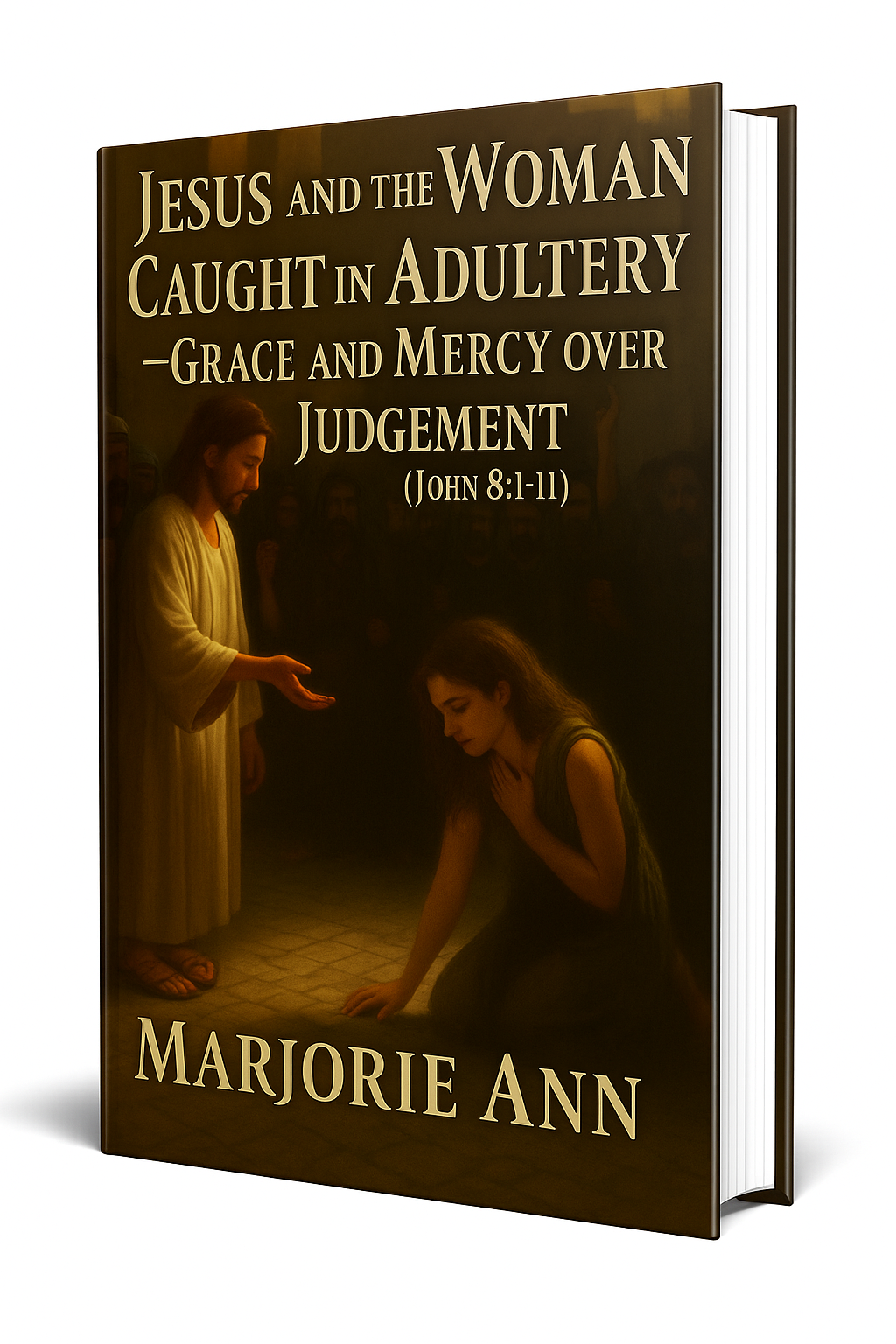
📘 Jesus and the Woman Caught in Adultery – Grace and Mercy Over Judgement
A powerful retelling of John 8:1-11. This book brings to life the depth of forgiveness, mercy, and God’s unwavering love.
👉 Check it now on Amazon
As a ClickBank Affiliate, I earn from qualifying purchases.
Acknowledgment: All Bible verses referenced in this article were accessed via Bible Gateway (or Bible Hub).
“Want to explore more? Check out our latest post on Why Jesus? and discover the life-changing truth of the Gospel!”





